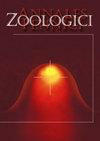Erythrotes murzini (Coleoptera : Cerambycidae), a New Genus and Species of Longicorn Beetles from China
IF 0.9
4区 生物学
Q4 ECOLOGY
引用次数: 2
Abstract
Erythrotes murzini gen. nov. and sp. nov. from China (Sichuan Province) is described and illustrated. The new genus is close to EupromusPascoe, 1868, but the latter has smaller eyes, elytra with distinct costae and big punctation, mesocoxal process with distinct distal tubercle, and pronotum with black central line. Elytra of the species in Eupromus is not granulated. The new species described here is larger than most of the Eupromus species.中国天牛属一新种(鞘翅目:天牛科)
描述了中国(四川省)红藓属(Erythrotes murzini gen. 11 .和sp. 11 . 11 .)。新属与EupromusPascoe(1868)相近,但后者的眼睛较小,鞘翅有明显的肋状和大点状,中端突有明显的远端结节,前额有黑色中线。该种的鞘翅不是颗粒状的。这里描述的新物种比大多数的欧普罗莫斯物种都要大。
本文章由计算机程序翻译,如有差异,请以英文原文为准。
求助全文
约1分钟内获得全文
求助全文
来源期刊

Annales Zoologici Fennici
生物-动物学
CiteScore
2.40
自引率
14.30%
发文量
10
审稿时长
>12 weeks
期刊介绍:
Annales Zoologici Fennici publishes mainly original research reports, but also in-depth reviews and commentaries on all aspects of animal ecology and evolution, and fields related to them. Our aim is to promote papers which focus on the interactions among various components in the past and present environments by using integrative and cross-disciplinary approaches. This may be achieved by employing tools from different fields of research, such as (but not restricted to):
ecology and paleoecology,
molecular ecology and phylogeography,
conservation biology, human-induced contemporary evolution and wildlife management,
animal behaviour and interactions (including recognition systems and mechanisms),
paleontology (except systematics and taxonomy) and evolution,
bioenergetics.
 求助内容:
求助内容: 应助结果提醒方式:
应助结果提醒方式:


